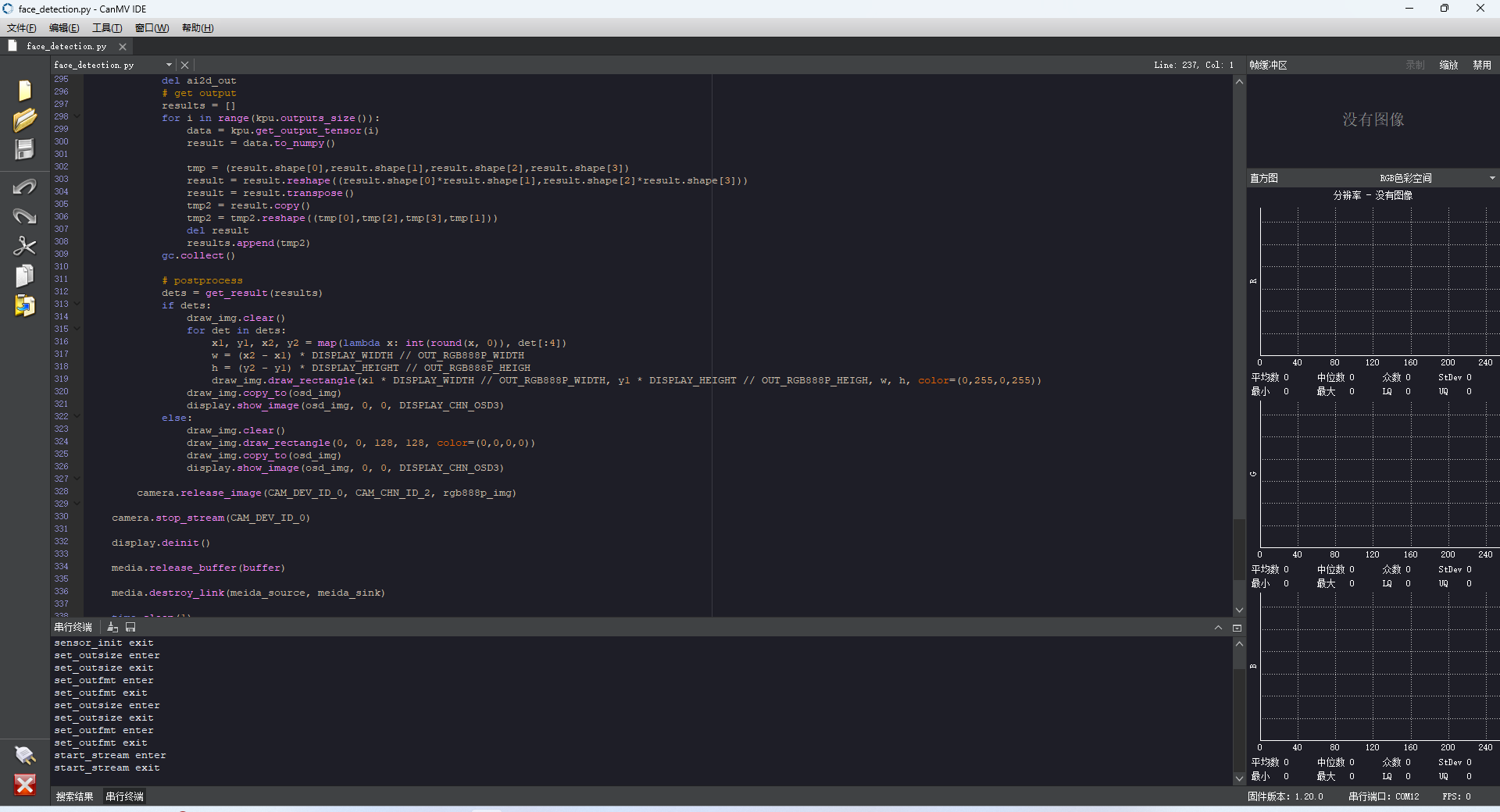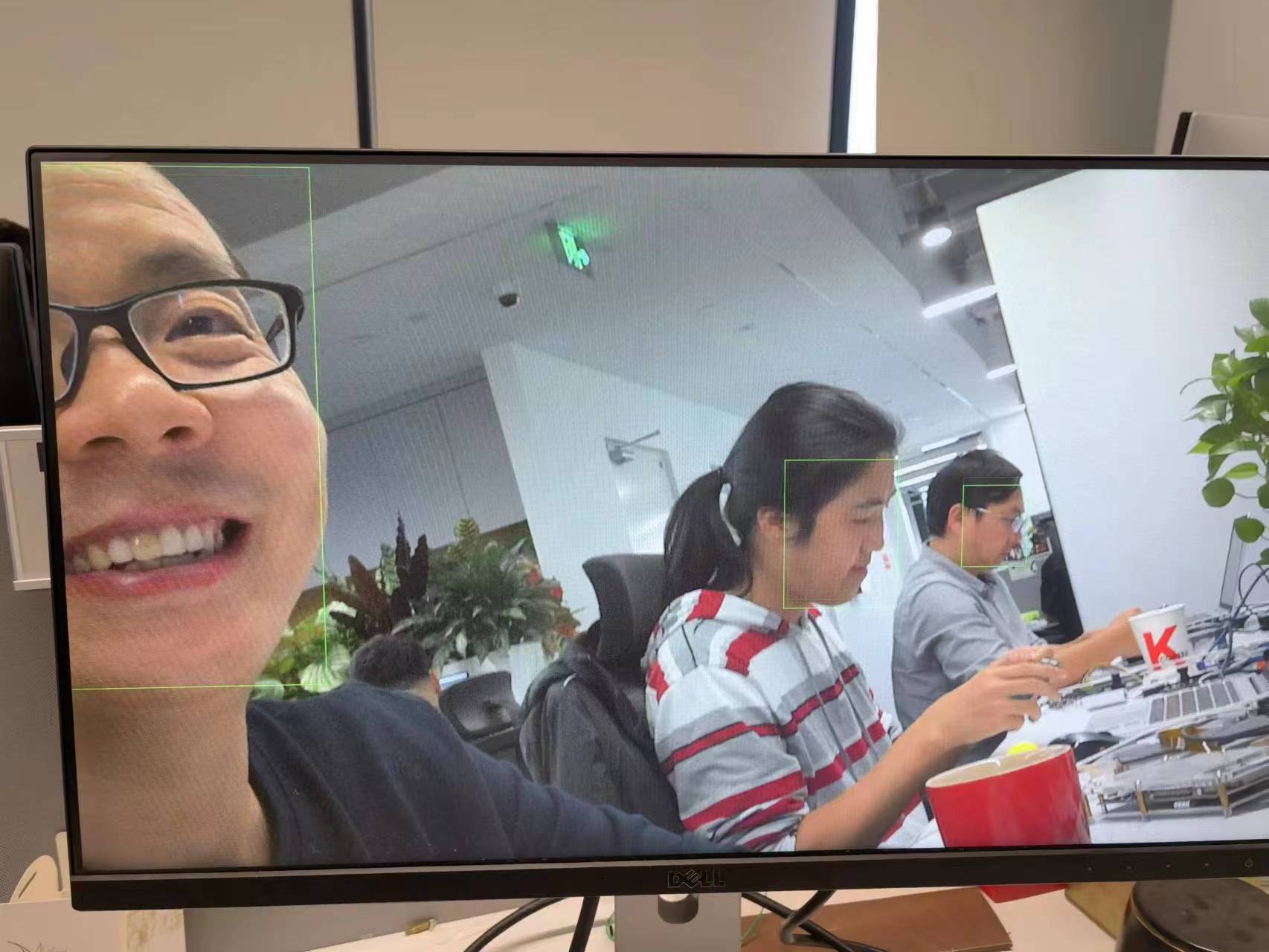2. 人脸检测示例#
1. 概述#
K230 CanMV 人脸检测是通过python语言开发实现的一个简单的具备摄像头数据采集预览,人脸检测画框功能的应用。该示例程序应用到了K230 CanMV 平台的多个硬件模块:AI2D,KPU,Camera,Display等。
2. 硬件环境#
运行该示例程序需要如下硬件环境:
K230 CanMV开发板及配套的Sensor模组
3. 示例代码#
import os
from media.sensor import * #导入camera模块,使用camera相关接口
from media.display import * #导入display模块,使用display相关接口
from media.media import * #导入media模块,使用meida相关接口
from time import *
import nncase_runtime as nn #导入nn模块,使用nn相关接口
import ulab.numpy as np #导入np模块,使用np相关接口
import time
import image
import random
import gc
DISPLAY_WIDTH = ALIGN_UP(1920, 16)
DISPLAY_HEIGHT = 1080
OUT_RGB888P_WIDTH = ALIGN_UP(1024, 16)
OUT_RGB888P_HEIGH = 624
confidence_threshold = 0.5
top_k = 5000
nms_threshold = 0.2
keep_top_k = 750
vis_thres = 0.5
variance = [0.1, 0.2]
anchors_path = '/sdcard/app/tests/nncase_runtime/face_detection/prior_data_320.bin'
prior_data = np.fromfile(anchors_path, dtype=np.float)
prior_data = prior_data.reshape((4200,4))
scale = np.ones(4, dtype=np.uint8)*1024
scale1 = np.ones(10, dtype=np.uint8)*1024
def decode(loc, priors, variances):
boxes = np.concatenate(
(priors[:, :2] + loc[:, :2] * variances[0] * priors[:, 2:],
priors[:, 2:] * np.exp(loc[:, 2:] * variances[1])), axis=1)
boxes[:, :2] -= boxes[:, 2:] / 2
boxes[:, 2:] += boxes[:, :2]
return boxes
def decode_landm(pre, priors, variances):
landms = np.concatenate((priors[:, :2] + pre[:, :2] * variances[0] * priors[:, 2:],
priors[:, :2] + pre[:, 2:4] * variances[0] * priors[:, 2:],
priors[:, :2] + pre[:, 4:6] * variances[0] * priors[:, 2:],
priors[:, :2] + pre[:, 6:8] * variances[0] * priors[:, 2:],
priors[:, :2] + pre[:, 8:10] * variances[0] * priors[:, 2:])
, axis=1)
return landms
def py_cpu_nms(dets, thresh):
"""Pure Python NMS baseline."""
x1 = dets[:, 0]
y1 = dets[:, 1]
x2 = dets[:, 2]
y2 = dets[:, 3]
scores = dets[:, 4]
areas = (x2 - x1 + 1) * (y2 - y1 + 1)
order = np.argsort(scores,axis = 0)[::-1]
keep = []
while order.size > 0:
i = order[0]
keep.append(i)
new_x1 = []
new_x2 = []
new_y1 = []
new_y2 = []
new_areas = []
for order_i in order:
new_x1.append(x1[order_i])
new_x2.append(x2[order_i])
new_y1.append(y1[order_i])
new_y2.append(y2[order_i])
new_areas.append(areas[order_i])
new_x1 = np.array(new_x1)
new_x2 = np.array(new_x2)
new_y1 = np.array(new_y1)
new_y2 = np.array(new_y2)
xx1 = np.maximum(x1[i], new_x1)
yy1 = np.maximum(y1[i], new_y1)
xx2 = np.minimum(x2[i], new_x2)
yy2 = np.minimum(y2[i], new_y2)
w = np.maximum(0.0, xx2 - xx1 + 1)
h = np.maximum(0.0, yy2 - yy1 + 1)
inter = w * h
new_areas = np.array(new_areas)
ovr = inter / (areas[i] + new_areas - inter)
new_order = []
for ovr_i,ind in enumerate(ovr):
if ind < thresh:
new_order.append(order[ovr_i])
order = np.array(new_order,dtype=np.uint8)
return keep
def pad_img_to_square(image, rgb_mean):
height, width, _ = image.shape
long_side = max(width, height)
image_t = np.empty((long_side, long_side, 3), dtype=image.dtype)
image_t[:, :] = rgb_mean
image_t[0:0 + height, 0:0 + width] = image
return image_t
def softmax(x):
x = x[0]
x_row_max = np.max(x,axis=-1)
x_row_max = x_row_max.reshape(tuple(list(x.shape)[:-1]+[1]))
x = x - x_row_max
x_exp = np.exp(x)
x_exp_row_sum = np.sum(x_exp,axis=-1).reshape(tuple(list(x.shape)[:-1]+[1]))
softmax = x_exp / x_exp_row_sum
return softmax
def draw_image(img_raw,dets):
pass
def get_result(output_data):
loc = []
loc = np.zeros((1, 4200, 4), dtype=np.float)
start_i = 0
for _i in range(0, 3):
sum_shape = 1
for sh_i in output_data[_i].shape:
sum_shape *= sh_i
output_data[_i] = output_data[_i].reshape((1, -1, loc.shape[2]))
loc[:,start_i:start_i + int(sum_shape/loc.shape[2]),:] = output_data[_i]
start_i = start_i + int(sum_shape/loc.shape[2])
#conf = []
start_i = 0
conf = np.zeros((1, 4200, 2), dtype=np.float)
for _i in range(3, 6):
sum_shape = 1
for sh_i in output_data[_i].shape:
sum_shape *= sh_i
output_data[_i] = output_data[_i].reshape((1, -1, conf.shape[2]))
conf[:,start_i:start_i + int(sum_shape/conf.shape[2]),:] = output_data[_i]
start_i = start_i + int(sum_shape/conf.shape[2])
conf = softmax(conf)
#landms = []
#for _i in range(6, 9):
##landms.append(np.reshape(np.transpose(output_data[_i], [0, 2, 3, 1]), [1, -1, 10]))
#landms.append(np.reshape(output_data[_i],(1, -1, 10)))
#landms = np.hstack(landms)
boxes = decode(loc[0], prior_data, variance)
boxes = boxes * scale
scores = conf[:, 1]
#landms = decode_landm(np.squeeze(landms, axis=0), prior_data, variance)
#landms = landms * scale1
# ignore low scores
inds = []
boxes_ind = []
scores_ind = []
for i in range(len(scores)):
if scores[i] > confidence_threshold:
inds.append(i)
boxes_ind.append(boxes[i])
scores_ind.append(scores[i])
boxes_ind = np.array(boxes_ind)
scores_ind = np.array(scores_ind)
#landms = landms[inds]
# keep top-K before NMS
order = np.argsort(scores_ind, axis=0)[::-1][:top_k]
boxes_order = []
scores_order = []
for order_i in order:
boxes_order.append(boxes_ind[order_i])
scores_order.append(scores_ind[order_i])
if len(boxes_order)==0:
return []
#print('***',boxes_order,len(boxes_order))
#print('***',scores_order,len(scores_order))
boxes_order = np.array(boxes_order)
scores_order = np.array(scores_order).reshape((-1,1))
#landms = landms[order]
# do NMS
dets = np.concatenate((boxes_order, scores_order), axis=1)
keep = py_cpu_nms(dets, nms_threshold)
dets_out = []
for keep_i in keep:
dets_out.append(dets[keep_i])
dets_out = np.array(dets_out)
#landms = landms[keep]
# keep top-K faster NMS
dets_out = dets_out[:keep_top_k, :]
#landms = landms[:args.keep_top_k, :]
# dets = np.concatenate((dets, landms), axis=1)
return dets_out
def face_detect_test():
print("face_detect_test start")
#初始化KPU
kpu = nn.kpu()
#初始化AI2D
ai2d = nn.ai2d()
#加载模型
kpu.load_kmodel("/sdcard/app/tests/nncase_runtime/face_detection/face_detection_320.kmodel")
ai2d.set_dtype(nn.ai2d_format.NCHW_FMT,
nn.ai2d_format.NCHW_FMT,
np.uint8, np.uint8)
ai2d.set_pad_param(True, [0,0,0,0,0,125,0,0], 0, [104,117,123])
ai2d.set_resize_param(True, nn.interp_method.tf_bilinear, nn.interp_mode.half_pixel )
ai2d_builder = ai2d.build([1,3,OUT_RGB888P_HEIGH,OUT_RGB888P_WIDTH], [1,3,320,320])
# 初始化并配置sensor
sensor = Sensor()
sensor.reset()
sensor.set_hmirror(False)
sensor.set_vflip(False)
# 通道0直接给到显示VO,格式为YUV420
sensor.set_framesize(width = DISPLAY_WIDTH, height = DISPLAY_HEIGHT)
sensor.set_pixformat(PIXEL_FORMAT_YUV_SEMIPLANAR_420)
# 通道2给到AI做算法处理,格式为RGB888
sensor.set_framesize(width = OUT_RGB888P_WIDTH , height = OUT_RGB888P_HEIGH, chn=CAM_CHN_ID_2)
# set chn2 output format
sensor.set_pixformat(PIXEL_FORMAT_RGB_888_PLANAR, chn=CAM_CHN_ID_2)
# OSD图像初始化
osd_img = image.Image(DISPLAY_WIDTH, DISPLAY_HEIGHT, image.ARGB8888)
sensor_bind_info = sensor.bind_info(x = 0, y = 0, chn = CAM_CHN_ID_0)
Display.bind_layer(**sensor_bind_info, layer = Display.LAYER_VIDEO1)
# 设置为LT9611显示,默认1920x1080
Display.init(Display.LT9611, to_ide = True)
try:
# media初始化
MediaManager.init()
# 启动sensor
sensor.run()
rgb888p_img = None
while True:
#捕获摄像头数据
rgb888p_img = sensor.snapshot(chn=CAM_CHN_ID_2)
if rgb888p_img == -1:
print("face_detect_test, capture_image failed")
continue
# for rgb888planar
if rgb888p_img.format() == image.RGBP888:
ai2d_input = rgb888p_img.to_numpy_ref()
ai2d_input_tensor = nn.from_numpy(ai2d_input)
data = np.ones((1,3,320,320),dtype=np.uint8)
ai2d_out = nn.from_numpy(data)
ai2d_builder.run(ai2d_input_tensor, ai2d_out)
#设置kpu输入
kpu.set_input_tensor(0, ai2d_out)
#运行kmodel
kpu.run()
del ai2d_input_tensor
del ai2d_out
# get output
results = []
for i in range(kpu.outputs_size()):
data = kpu.get_output_tensor(i)
result = data.to_numpy()
tmp = (result.shape[0],result.shape[1],result.shape[2],result.shape[3])
result = result.reshape((result.shape[0]*result.shape[1],result.shape[2]*result.shape[3]))
result = result.transpose()
tmp2 = result.copy()
tmp2 = tmp2.reshape((tmp[0],tmp[2],tmp[3],tmp[1]))
del result
results.append(tmp2)
gc.collect()
#获取人脸检测结果
dets = get_result(results)
osd_img.clear()
if dets:
for det in dets:
x1, y1, x2, y2 = map(lambda x: int(round(x, 0)), det[:4])
w = (x2 - x1) * DISPLAY_WIDTH // OUT_RGB888P_WIDTH
h = (y2 - y1) * DISPLAY_HEIGHT // OUT_RGB888P_HEIGH
#绘制人脸框
osd_img.draw_rectangle(x1 * DISPLAY_WIDTH // OUT_RGB888P_WIDTH, y1 * DISPLAY_HEIGHT // OUT_RGB888P_HEIGH, w, h, color=(255,255,0,255))
Display.show_image(osd_img, 0, 0, Display.LAYER_OSD3)
rgb888p_img = None
except Exception as e:
print(f"An error occurred during running: {e}")
finally:
os.exitpoint(os.EXITPOINT_ENABLE_SLEEP)
#停止摄像头输出
sensor.stop()
#去初始化显示设备
Display.deinit()
#释放媒体缓冲区
MediaManager.deinit()
del kpu #释放kpu资源
del ai2d #释放ai2d资源
gc.collect()
time.sleep(1)
print("face_detect_test end")
return 0
face_detect_test()
4. 运行示例代码#
通过K230 CanMV IDE 打开示例程序代码,并点击运行按钮开始运行人脸检测示例程序。有关IDE的使用请参考《K230_CanMV_IDE使用说明》,有关镜像烧录及开发环境搭建请参考《K230_CanMV使用说明》
通过IDE打开示例程序并运行如下图所示:

运行结果如下图所示:
